  |
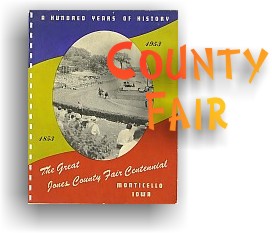 |
|||
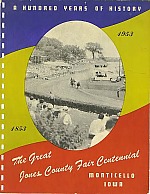
|
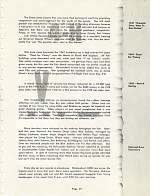 The Great Jones County Fair was more than proving its worth by providing competition and encouragement for the youth of the county. The 4-H stock parade was scheduled for Thursday night instead of Thursday afternoon, because it had grown so in size, importance and interest. 4-H activities had become so extensive that there was little room for commercial producers' competition. Friday of 1941 became the greatest single day in Jones County Fair history . . . over fifteen thousand people jammed the midway to a standstill, bearing out Governor George Wilson's assertion after his Thursday visit, that the Monticello Fair was "the greatest seen, next to Des Moines." The Great Jones County Fair was more than proving its worth by providing competition and encouragement for the youth of the county. The 4-H stock parade was scheduled for Thursday night instead of Thursday afternoon, because it had grown so in size, importance and interest. 4-H activities had become so extensive that there was little room for commercial producers' competition. Friday of 1941 became the greatest single day in Jones County Fair history . . . over fifteen thousand people jammed the midway to a standstill, bearing out Governor George Wilson's assertion after his Thursday visit, that the Monticello Fair was "the greatest seen, next to Des Moines."
War once more keynoted the 1942 exhibition as it had twenty-five years before. "Food for Victory" was the theme of Floral Hall displays. All Fair buildings were decorated with red, white and blue "V for Victory" motifs. War stamp corsages were seen everywhere. At previous Fairs, cars had been given away, but this year the Fair board announced that net profits would go to war service organizations. Government excise taxes added five cents to each fifty cent admission. War spotlighted the baseball scene, too, as Camp Grant's Army team met and conquered Navy Pre-flight from Iowa City, 9-8. A record racing field of seventy-two horses competed for a $2,200 total purse at the 1943 Fair. Twenty-one entries ran for the $500 money in the 2:28 pace stake race and thirteen tried for a like amount in the 2:28 trot stake race. War invaded the midway as concessionaires found the rubber shortage affecting not only rubber tires, but also rubber ball games. Others took advantage of war fervor by using Hitler and Hirohito as targets for baseball and pistol shooting games. When players at one stand complained that it was impossible to toss hoops over the large wooden blocks, the concessionaire replied with magnificent patriotism, "Nothing's impossible, my friends; the Japs think it's impossible to lick them, but they are finding out different, too." Navy recruiters were stationed on the midway throughout the Fair. Baseball this year featured the famous Great Lakes Blue Jackets, managed by Mickey Cochrane, former Major League catcher and Detroit Tiger manager, who played the Camp Grant, Illinois team. Line-ups included baseball stars Johnny Mize, John Schmitz, Don Kolloway, Ed Pellegrini, Tom Ferrick and others. Over ten thousand people saw the Blue Jackets win 9-3 that afternoon. Due to gas and tire rationing, the Milwaukee Railway "jitney" adjusted its schedule to accommodate Cedar Rapids fair visitors, just as excursion trains had done years before. In spite of rationing more than twenty thousand people attended the Fair, many of them remarking that 'they'd been saving up special, for you just can't miss the Jones County Fair. Every day set new records in attendance. Wednesday's $500 race purse, the highest paid in Iowa that year, drew many spectators. On Thursday, Midway stands were entirely sold out and Bill Jarrett appeared haggard from frying hamburgers in his stand from 8 a.m. until 2:30 the next morning. |

|
||
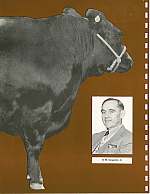 |  "Something different in the way of a steer show will be staged in Monticello, Iowa, in connection with the Great Jones County Fair this year," announced the Chicago Daily Drovers Journal in regard to the initial Fat Steer Contest held in 1944. It was the first such show seen in this country . . . a steer show based solely on market values and not on show ring technicalities. It was the brain child of H. M. "Stead" Carpenter, Jr., The Drovers Journal continued: "Something different in the way of a steer show will be staged in Monticello, Iowa, in connection with the Great Jones County Fair this year," announced the Chicago Daily Drovers Journal in regard to the initial Fat Steer Contest held in 1944. It was the first such show seen in this country . . . a steer show based solely on market values and not on show ring technicalities. It was the brain child of H. M. "Stead" Carpenter, Jr., The Drovers Journal continued:
The prophecy has more than come true. Carpenter's show not only brought the commercial producer back to Monticello competition, but proved its fascination for a widespread public, as similar shows have since sprung up all over the country. Producers from distant states annually join the competition here. The first year of the show, fifty two steers were in competition for $1,445 in prizes, with a first prize of $610. Rules specified that all steers were to be at least two years old and weigh over 1200 pounds. The judging was done by packing house buyers, the best judges available of what potentially juicy, succulent steaks and ribs look like on the hoof. Permanent pens and bleachers were built north of Floral Hall, in a pleasant, shady area, and over two thousand people watched as a 1,360 pound Hereford belonging to Ray Kurt of Cascade took the coveted first prize. The steer brought $28.50 per hundred-weight at the auction following the judging. Competition that first year was, by chance, entirely among producers within a relatively short distance of Monticello - but that kind of competition is said, by Chicago cattlemen, to be among the most rugged in the country. Second money, $366, was awarded an Angus entered by J. F. Mommsen of Miles, a Clinton County entry. Others sharing in the $1,445 prize money of the memorable first Fat Steer Show were Roy Coverdale of Delmar, J. P. Flannagan of Coggon, John P. Kurt and George Kurt of Cascade. A record $4,200 race purse drew much attention to the harness events, as four $800 purses and two $500 purses attracted a fast field from Iowa, Illinois and Minnesota.
|
|||
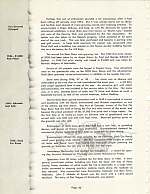

|
Perhaps that sort of enthusiasm sounded a bit monotonous after it had been rolling off annually since 1874. But it was always borne out as shows and facilities kept abreast of every-growing crowds and widening interests. To accommodate a larger Midway, and keep up with the demands for space by commercial exhibitors, a level three acre tract known as "Clark's Lots," located just west of the Country Club was purchased by the Fair Association. An option was also taken on the Bajasch property, which consisted of 33 acres east of the race track. This was later purchased and became a parking area and golf course. A large brick rest-room for women was constructed near Floral Hall and a building was erected on the former poultry building foundation as a dormitory for the 4-H boys.
The annual Fat Steer Show was growing, too. The 1945 first prize money of $750 had been taken by an Angus shown by Fred and George Schmidt of Delmar. In 1946 first prize money was raised to $1,000 and was taken by Herman Helgens of Monticello. Entries of 4-H projects were the largest in Eastern Iowa. Free attractions were on the spectacular side, as the WHO Barn Dance and the All-American Thrill Show provided varied entertainment, in addition to the regular free acts. Some time during 1946, '47 or '48 . . . her name was so obscure and unheralded at the time that no one remembered the exact year . . . a hill billy style singer appeared here in one of the acts. An attractive girl, with talent and personality, she was included in fair movies taken at the time. Her name was, or is now, Jeanette Davis of radio and TV fame and almost as much a household byword, as that of her current employer, Arthur Godfrey. The Fat Steer Show gained momentum until in 1949 it was ranked in interest and excellence with the Royal, International and Western expositions as one of the nations top four shows. Ray Kurt of Cascade, winner of the first Fat Steer Show had the thrill of being the first two time winner of the event, and became the proud possessor of the $1,000 first prize and a huge trophy. For the first time in its ninety-six years an advance sale of grandstand and reserved seats was held and met with high favor. Reserved parking space on the grounds was also sold. Enforcement of State Laws gave the 1950 Fair a new look, as gambling devices and games of chance were prohibited. Unprecedented demand for commercial display space more than took up space left by their closing. Entertainment offered this year included, for the first time, Stock Car Races, which were gaining wide interest. The Fair association had sought to satisfy all tastes and found more than twenty-five thousand people jamming the grounds on Saturday, the last day of the Fair, for the event. Attendance Wednesday had reached ten thousand . . . a record for opening day, fourteen thousand on Thursday and sixteen thousand on Friday. Spectators from 20 states watched the Fat Steer Show in 1950. It drew several out-of-state entries, including one from the boys' 4-H club of Pecos County, Texas, members of which made the trip to Monticello in a large semi-trailer converted to sleeping quarters, cooking meals along the roadside as they traveled. Also represented were Kremmeley, Colorado and Boys Town, Nebraska. John C. Neibohr of Dysart won the event with a 1,210 pound Hereford. The entry of Gus Tietgen of Comanche was second. |
|||
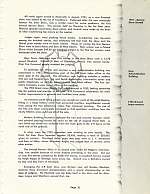 |
All roads again turned to Monticello in August, 1951, as a new livestock show was added to the list of headliners. Patterned after the now nationally famous Fat Steer Show, was a similar event for swine producers, the first Annual Barrow Show. This contest, held on Thursday in the Fat Steer pens, likewise ignored usual fancy show points, and awards were made on the basis of what would bring top money on the market.
Judges again were packing house buyers. Competition was top-notch among the hundred entries, and exhibitors felt that both the show and the liberal prize money were of much interest. Honor of wining the first Barrow Show went to Louis Ruess and Sons of West Liberty. Their winner was a Poland China which brought $49.50 per hundred weight as the first ten winners were auctioned after the show. Boys Town, Nebraska took first money in the Steer Show with a 1,175 pound Hereford. William T. Weir of Gladstone, Illinois, won second money. Over five thousand people watched the judging. To centralize fair offices and services, a new administration building was constructed in 1951, incorporating part of the old brick ticket office at the main gate of the grounds. The attractive, new building includes a modern first aid and hospital unit, lost and found department, information center and public telephones, as well as administrative and ticket offices. The Fair secretary maintains a year round office in this building. The 99th Great Jones County Fair rolled around in 1952, feeling somewhat like the preface and preview to the gala 1953 Centennial celebration, for even further improvements in grounds and facilities were made. An extensive earth filling project was carried out, north of the amphitheatre, filling in a large hollow which had prevented overflow amphitheatre crowds from seeing the free attractions, unless they remained standing. The size of the free acts stage was greatly increased so that spectators watching from the newly filled-in area could see all of the acts. Modern drinking fountains replaced the iron and concrete fountain which had sprayed passing crowds for years on the site of original Floral Hall. A new black top street was surfaced from the main gate to the 4-H barns at the north end of the grounds. In other ways the 1952 exposition was winning its own laurels. The Ninth Fat Steer Show awarded another $3,450, making a total of $28,095 given its winners. Thousand dollar prize that year went to J. F. Mommsen and Sons of Miles, whose Aberdeen Angus was judged best of seventy seven other entries. The Annual Barrow Show in its second year under Ed Helgen's chairmanship, was smaller because of swine disease prevailing in the state. But out of sixty five entries competing for $200 first money, a crossbreed barrow owned by Ralph Keppy of Eldridge came away top. Second was a Berkshire owned by Bob and Ray Faint of Havelock. Sweeping the 4-H beef show was thirteen year old Gordon Eberhart, claiming three divisional championships and a grand championship at the close of judging. His Hereford was top baby beef in the show and his Aberdeen Angus and Shorthorn earned first, too. |
|||
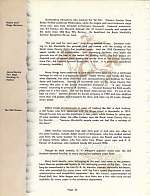 |
Outstanding attractions also marked the '52 Fair. Western Frontier Days Rodeo thrilled audiences Wednesday, while the largest and most elaborate stage revue ever seen here attracted enthusiastic thousands. Featured entertainer was the famous Joe Howard, beloved star of musical comedy and emcee of the radio show CBS Gay 90's Review. He headlined the Boyle Woolfolk's Summer Sensations Revue, here.
"But just wait for next year," everything seemed to say. Certainly nothing on the Monticello fair grounds had yet ranked with the ending of the Great Jones County Fair's first hundred years. And the 1953 Centennial Fair seems worthy of all expectations. Ever improving facilities, now make the grounds one of the best in the nation for holding fairs. The Fair enjoys undisputed rank of second place among the county fairs of the nation. (Another Iowa Fair, the famous Spencer Exposition, is first. It is generally considered tri-county, however.) Many things have combined to give the hundred year old Fair a continued heritage as well as a progressive future. Nobel Winner and Candy Bill have since departed, but other showmen and concessionaires are bidding for their fame and familiarity. Starting its fourteenth year on the Jones County Fair midway this year is the Sunset Amusement Company . . . "a very unusual record," according to owner K. H. Garmen . . . "unusual because the field usually plays out in a few years. But not the Great Jones County Fair. It's one of the best we work." Garmen formed his Sunset company in 1929 and now employs more than 185 people and transports his show and rides via 45 trucks, through seven states. Oldest single concessionaire in years of 'making the fair' is Jack Lindsay, a tall Texas who first appeared with his Bingo stand in Monticello in 1919. Though his son has run the stand here in late years, while Lindsay Sr. takes care of more southern dates, the older Lindsay says the Great Jones County Fair is his favorite . . . "because Monticello people made me feel like a resident of the town." Other familiar concession men seen here year in and year out, often in the same location, include: Ralph Jewett of Davenport, who has vended carmel corn from the same location for twenty-two years; Joe Ristick and his family of Gypsy fortune tellers, who first came here fifteen years ago; and C. R. Farmer of Anamosa, who replaced Candy Bill around 1930. Though he died recently, D. V. Morgan's popcorn stand near the old fountain became familiar to many during his eighteen years here. Many local people, some belonging to the past, and some to the present, have likewise contributed loyally to the continuing success of the Fair. One to long be remembered is the late Dr. A. M. Maurice, veteran Monticello horseman, who was connected for many years with the Fair's speed department in both administrative and competitive capacities. Mrs. Ida Iverson, superintendent of Floral Hall, Mrs. Mike Hogan and Mrs. Ava Main are a few who have served faithfully for many years in the exhibitors department. |

|
||
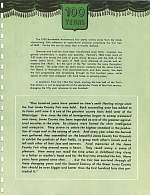 |
The 1953 Hundredth Anniversary Fair seems worlds away from the timid, unpromising little collection of agricultural products comprising the first Fair of 1853. Yet the two are far closer than is readily realized.
Grounds and facilities have been transformed since 1874. Livestock has gained unbelievably in quality and quantity. Peavine's 1866 track mark of 2:52 looks dim beside the 2:06 of pacer Jimmy Bumpus and the 2:08 of the trotter Jackie Davis. Fair goers of 1853 never dreamed of crowds and attractions like 1953's. But the spirit of the Fair remains the same throughout the Century. The pride taken by Jones County residents and the Jones County Fair Board, in themselves, their accomplishments, and their county, has kept the Fair progressing and developing though its first hundred years, while dozens of other fairs collapsed with hard times, or growing pains. A quotation from the 1904 Fair book, starting the last half of the Fair's first century, is just as appropriate at the spectacular finale of that first century, changing the fifty year reference to one hundred: "One hundred years have passed on time's swift fleeting wings since the first Jones County Fair was held. Each succeeding year has added to its fame until now it is one of the greatest county fairs held west of the Mississippi. Ever since the tide of immigration began to sweep westward over Iowa, Jones County has been regarded as one of the greatest agricultural counties in the state. Its citizens were famed for their intelligence and enterprise. They strove to attain the highest standard in the production of crops and in the raising of stock. And every year when the harvest was gathered they assembled on the beautiful Jones County Fair Grounds to exhibit the products of their fields, to grasp each other's hands and to tell each other of their joys and sorrows. Fond memories of the Jones County Fair cling around many a heart. They recall many a scene of pleasure. How many can recall the time when in childhood they clung to a father or mother's hand and for the first time attended the Fair. Many years have passed since then . . . but the Fair has survived through all these changing years and the Second Century of the Great Jones County Fair should be even bigger and better than the first hundred fairs that preceeded it." |
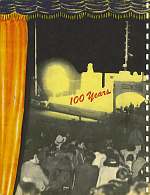 | ||

© Copyright 1997-2013, The Art Department, © Copyright 2014-2020, Richard Harrison.
| ||||
